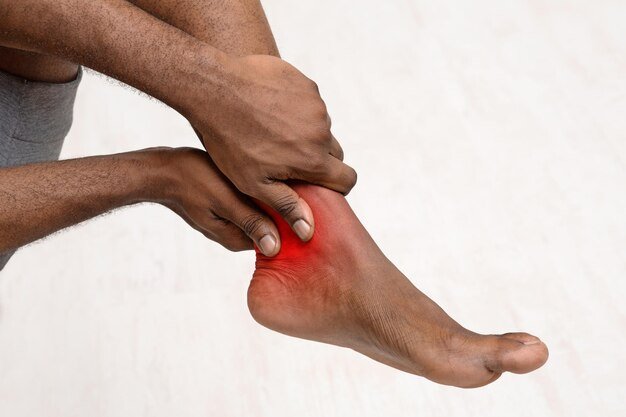Hello friends, it is another opportunity to discuss another important health matter; therefore, welcome to the publication. The issue for discussion is Plantar Fasciitis". Thanks to @ashkhan for the class.
 Source Source |
|---|
Plantar fascia is a hardened area of the skin (especially on the foot) caused by repeated friction, wear, or use. It is a band of thick tissue running through the foot's bottom, linking the heel bone and the toes. It makes provision for support to the foot arc and assists in absorbing shock while walking or running.
Plantar Fasciitis refers to a common condition affecting the bottom and heel of the foot. It happens when the plantar fascia, which is a group of tissue supporting the foot arc, becomes irritated or inflamed.
Plantar fasciitis can be caused by overuse resulting from reiterated strain on the plantar fascia, mostly as a result of jumping, running, or other activities of high impact. It can equally be caused by poor foot mechanics resulting from abnormalities in the function manner of the foot like high arches or flat feet.
Plantar fasciitis can also be age-inclined, as it is common among people above 40. Obesity can be another cause of plantar fasciitis as excessive weight can add extra strain on the plantar fascia. Biomechanical issues like supination or overpronation can equally add strain to the plantar fascia thereby leading to plantar fasciitis.
A fusion of clinical evaluation, physical examination, and medical history is typically involved in diagnosing plantar fasciitis. The following are some common methods used for diagnosing plantar fasciitis:
1. Clinical Evaluation
- Medical History: As a doctor, I will ask questions concerning the patient's medical history, symptoms, and lifestyle.
- Physical Examination: Will also carry out an examination on the foot and ankle, checking for swelling, tenderness, and range of motion.
2. Physical Examination Tests
- Palpation: Apply pressure to the plantar fascia to examine for tenderness.
- Toe Walking Test: Ask the patient to walk on his/her toes to examine the pain and rigidity in the plantar fascia.
- Heel Raise Test: Ask the patient to stand on toes and then lower heels for examination of pain and stiffness in the plantar fascia.
3. Imaging Studies
- X-rays: May order an X-ray to rule out other conditions like bone spur or stress fracture.
- MRI (Magnetic Resonance Imaging): MRI may be ordered for the confirmation of the diagnosis of plantar fasciitis and for ruling out other conditions like a heel spur or torn plantar fascia.
Special tests such as the windlass test,t in which the doctor applies pressure to the plantar fascia to check for pain and stiffness while the patient is standing,g can be carried out. Furthermore, a media tubercle test in which the doctor applies pressure to the bony prominence on the heel bone (known as medial tubercle) for checking pain and stiffness can equally be carried out.
https://youtube.com/shorts/86WDW7AzBGs?si=-7jT5ff7-adDA8VY
https://youtube.com/shorts/NfatR5rnIvA?si=rxsgPljhap8vc57W
https://youtube.com/shorts/bmvRj4WB1co?si=ohja-ioeC5cv2p60
The exercises carried out were observed to be beneficial in the following ways:
- Reduction of muscle tension
- Improvement of ankle mobility
- Can reduce risk of injury
- Can improve athletic performance
- Enhanced toe mobility
- Reduction of pain and discomfort
- Enhanced balance and stability
- Reduced risk of toe injuries
- Reduced heel pain
- Improved foot mobility
- Reduced inflammation
- Improved overall foot health
Thanks for your time on my blog; I am inviting @bossj23, @eunic,e and @divinelife.
X promotion link
Downvoting a post can decrease pending rewards and make it less visible. Common reasons:
Submit
Hello! it is good to get new knowledge about this common issue that many people suffer worldwide, the exercises are fun and easy to do, it is important to keep our plantar fascia strengthened.
Have a nice day!
Downvoting a post can decrease pending rewards and make it less visible. Common reasons:
Submit
Thank you for understanding the lesson and sharing your assignment; I hope that you will enjoy this week's lesson and try to implement it in your life if you see any such case.
Observations
Task 1 (2.6/3)
You have shared a great knowledge about plantar fasciitis, it's symptoms, causes, but you didn't add it's types. I appreciate your effort.
Task 2 (3/3)
In the second question, you tell us about how you have to assess a patient by doing physical examination and history taking, performing investigations and specialized tests. Excellent.
Task 3 (2.5/4)
You try the calf stretch. heel raise, try toe curls but not correct . You did the heel raise correctly. But I didn't understand the other exercises, at least mention the name of exercise so I can see the alternative position of that exercise. Always remember to cold therapy & rest is the best therapy in the treatment of plantar fasciitis. I appreciate your efforts.
Overall you made a great attempt to answer all the questions. I appreciate your efforts. But next time try to avoid the above written suggestions. Keep learning and try to implement your knowledge to the people suffering from plantar fasciitis or any type of heel pain. Thank you.
Downvoting a post can decrease pending rewards and make it less visible. Common reasons:
Submit